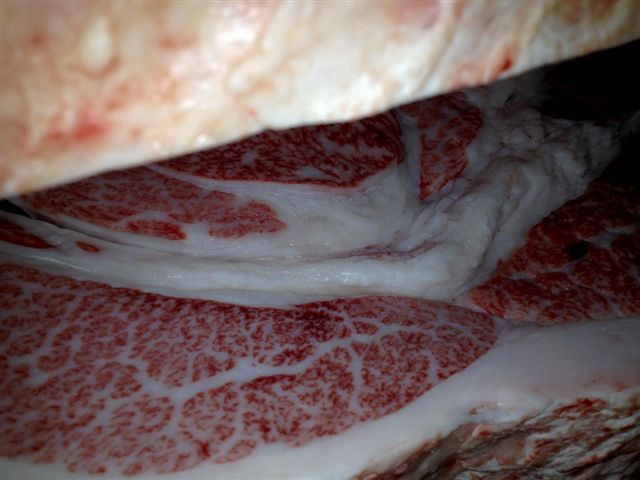The Value of Wagyu Marbling
Superior Wagyu marbling in the Japanese home market usually requires ~600 days on feed (DOF) – with slaughter at around 900 days of age. In Australian fullblood systems, this DOF period will add at least $1800 to the cost of every carcass, and many local feeders are experimenting with less expensive options, to the extent that there is no standard DOF period identifiable in Australian FB production in early 2015.
Feed periods range from 350 to 650 days, depending feedlot and desired carcass specification, but feeders may not enter the feedyard until 21moa or later. All of which makes ranking of individual pedigrees or breeding strategies extremely difficult – one breeding strategy may work well for an individual feed regime, and fail entirely in a different feeding program.
Nonetheless, relatively long feed helps make Wagyu the world’s most expensive beef, and potential failure of carcasses to meet high market expectation represents serious financial risk for feeder/processors (see Indicative Returns Table below). The obvious problem is that the measurement of marbling either as marble score/%IMF cannot be assessed by visual observation of live cattle.


AUS-MEAT Marble Score
Defined only after slaughter, AUS-MEAT marble score then describes measurement in relatively subjective commercial chiller assessment, while intramuscular fat (%IMF) traditionally describes a precise measurement in laboratory analysis (Wilkins et al, 2002).
To add confusion, %IMF is also a descriptor for a value of ultrasound measurement of live animal carcass traits, providing a predictive indicator for final marble score in the view of many producers.
CCMP however, is a scientific measurement of marbling percentage using digital imaging technology on the specific carcass. In the absence of both fullblood carcass data and CCMP technology, ultrasound measurement of IMF in live animals was adopted for the first Australian Wagyu EBVs – effectively a predictor for marbling potential in the eye of producers. For a number of years, Australian Wagyu Association BREEDPLAN then published an ultrasound-based %IMF EBV for measured animals.
This was intended to enable comparison of the %IMF potential of the individual animal via a +/- value over an annual average of submitted data. An accuracy (%ACC) value was allocated based on the number of ultrasound records supporting the prediction (there was no correlation with ANY actual carcass). However, in Australian fullblood Wagyu, this %IMF EBV has now been shown to be only marginally useful in predicting %IMF (or marble score).
AGBU Molecular Genetics Research Project
From about 2012, working with the Australian Wagyu Association and with Meat & Livestock Australia funding, the quasi-Government research organisation AGBU (Animal Genetics & Breeding Unit) at the University of New England, commenced a molecular genetics research project intended to identify more accurate Wagyu performance predictors (Genomic EBVs or GEBVs) using, for the first time, chiller data including camera images from a wide range of real, actual fullblood carcasses.
Amongst the early results from the project was the finding mentioned above that the %IMF EBV was accurate only to possibly 0.2 (20%) as a predictor. As a result, the AWA ceased publication of the %IMF EBV and of a closely related BREEDPLAN Fullblood Feeder $$$ Index, in which $$$ values had been substantially predicated on the presumed accuracy of the %IMF EBV.
The replacement result from the GEBV project is the AWA 2014 Research Sire Summary, discussed in this section.
Let’s Talk About Your Wagyu Breeding Plan
We'll Find the Right Wagyu Breeding Solution for You
Call us:
